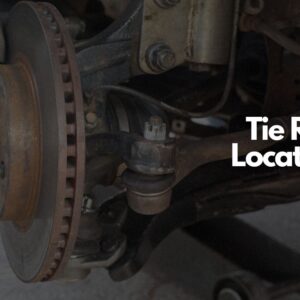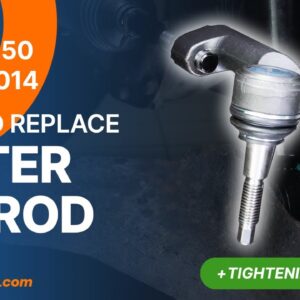When a tie rod breaks or suffers from any damage, you might notice difficulty steering the vehicle. This may cause you to lose control of the front wheels, and this is especially problematic since they determine the direction of your vehicle.
To get a better grasp of what you should do if your tie rods break, let’s take a closer look at how they work and what may cause them to malfunction.
What Are Tie Rods and What Do They Do?
Tie rods are among the most important parts of any vehicle because they allow drivers to steer the front wheels. They connect the steering rack to the steering arm. By extension, the steering arm is connected to the steering wheel.
Since tie rods are so important, they’re designed to be as tough and durable as possible. It’s not uncommon for them to be made of extremely high-quality steel, making them cost as much as $600.
Despite this, these components aren’t unbreakable. It’s a cause for alarm when one does break. Fortunately, familiarizing yourself with what happens when you break a tie rod can help you catch the issue early on to avoid having to do more repairs down the road.
What Happens When a Tie Rod End Breaks?
Tie rod ends are attached to each front wheel, connecting the steering gear to the steering knuckle. When they break, the wheels lose their connection to the steering assembly.
Common Symptoms of Faulty Tie Rods
It’s important to recognize when your tie rod is in bad shape to save yourself from a lot of unnecessary stress, not to mention danger.
Here are some of the most common signs to watch out for:
Clunky Noises From Vehicle
One common symptom that there’s something wrong with your vehicle’s tie rods is if your vehicle starts making clunky noises akin to knocking. This sound often comes from the front of your vehicle. This happens because broken or loose tie rods rattle around the joints and links. However, it’s also possible that the noise is being made by debris inside broken tie rod joints.

Misaligned Front End of Vehicle
Since tie rods help you steer your vehicle and keep it straight on the tracks, broken tie rods will negatively impact your vehicle’s handling. This makes it more difficult to control and steer, making you more at risk of getting into an accident on the road. Because of this, it’s important to address a damaged tie rod as quickly as possible.
Uneven and Excessive Tire Wear
When the front end of a vehicle is misaligned, the tires don’t share the same amount of load. This means your tires are at risk of wearing down unevenly, potentially at a faster rate than average. If one or more tires are more worn down than the others, it might be a good idea to get your tie rods checked.
Unresponsive Steering
Driving with damaged tie rods affects your ability to control your vehicle when you’re on the road. Wheel play increases while the overall responsiveness of the steering wheel decreases. This occurs because of the disconnect between the outer end of a tie rod which articulates and shifts about, and the steering knuckle it’s supposed to be connected to.
Vibrating Steering Wheel
If your steering wheel vibrates or feels loose when you drive, there’s a chance your vehicle’s tie rod has gotten loose or sustained damage. This vibration typically gets worse when you accelerate your vehicle or make a turn. Generally, vibration isn’t something that happens when tie rod ends are loose but if the steering wheel vibrates, it might be worth looking at the tie rods.
What Causes Tie Rods to Break Down?
Knowing the symptoms of faulty or broken tie rods is one thing, but knowing what causes tie rods to wear down is something else entirely. For those of you keen on familiarizing yourself with the various factors that can cause your tie rod to break early, read on.
General Wear and Tear
The most common factor that leads to broken tie rods is overuse. Vehicles are heavy, and the tie rods (along with other front-end components like ball joints) have to carry that load. Because of this, they tend to break down quickly compared to other parts of the vehicle. Simply driving your vehicle will wear down your tie rods. The more you do it, the faster this degradation happens.
Impact Damage
It’s also possible for tie rods to get damaged when you get into car accidents or whenever you drive over a particularly nasty pothole. Collisions can cause tie rods to bend, crack, or become misaligned. When this happens, you either need to repair the tie rod or get it replaced, otherwise the vehicle won’t be driveable.
Poor Lubrication
When tie rods aren’t lubricated, the different parts grind against one another as well as the steering assembly. Tie rods are threaded rods that are connected to the steering system. One end is attached to the steering knuckle, which in turn is connected to the steering wheel.
Because these parts are interconnected, these parts break down and destroy themselves at a much quicker rate than they would normally if even one of them malfunctions. It’s important to keep your tie rods well-greased to minimize the damage it receives from use.
What Should You Do When Your Tie Rod Breaks?
Depending on the severity of the damage your vehicle’s tie rod sustains, you should still be able to drive and control your vehicle (albeit with a lot of extra effort). However, if it’s clear that your tie rod is broken, drive to the nearest auto repair shop as quickly as possible. This is because a vehicle with a completely broken tie rod is completely undriveable.
It’s dangerous to drive with a damaged tie rod because your vehicle’s handling will inevitably get worse over time. Once they take damage, their condition declines rapidly before becoming unusable. In cases where there’s a risk of losing total control of your vehicle, your best bet is to have it towed instead.
Check out these videos for tips on how to replace your inner and outer tie rod:
Any information provided on this Website is for informational purposes only and is not intended to replace consultation with a professional mechanic. The accuracy and timeliness of the information may change from the time of publication.



























